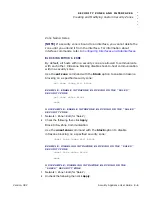
. . . . .
G E T T I N G S T A R T E D
Installing the freeGuard Blaze 2100
Version 3R2
Security Appliance User Guide
2-7
save
Optional—To verify the new interface settings, use the
get interface
command:
get interface {eth0|eth1}
G U I E X A M P L E : C O N F I G U R I N G I N T E R F A C E E T H 1
1
Network > Interface > Edit (for eth1)
2
Enter the following, then click
Apply
:
Zone Name: Untrust
Static IP: (select this option when present)
IP Address/Netmask: 10.0.0.1/24
C O N F I G U R I N G N E T W O R K A D D R E S S T R A N S L A T I O N ( N A T )
To configure the freeGuard Blaze 2100 to support a large number of
hosts on the eth0 interface behind a single public IP address assigned to
the eth1 interface, you must configure network address translation
(NAT). For additional information regarding NAT configurations, refer to
Chapter 10, “Address Translation.”
Use the
set interface
command to apply NAT to all packets as they pass
through the eth0 interface:
set interface eth0 nat
save
Optional—To verify the new interface settings, execute the
get interface
command:
get interface eth0
C O N F I G U R I N G T H E D E F A U L T R O U T E
Use the
set route
command to configure the default route for all traffic.
The
set route
command consists of the destination network, the
interface name, and the IP address to forward packets from that
interface.
Using the network in
Figure 2-2
as an example, use the
set route
command to configure the freeGuard Blaze 2100 to use the eth1
interface and a gateway address of
4.4.4.25
4 for the default route of all
traffic




































